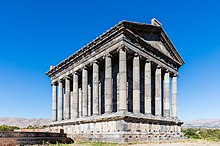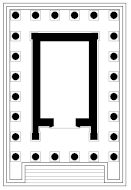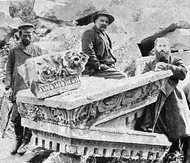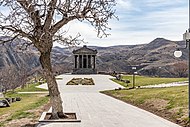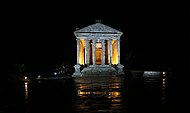Temple of Garni
Garni ( Armenian Գառնի ) is a temple complex in the province of Kotayk in Armenia , about 32 km southeast of Yerevan near the small town of Garni .
history
The first traces of human settlement date back to the third millennium BC and are grouped around an easily defendable loop of the Azat . In the 8th century BC, the Urartian king Argishti I conquered the area. The first written mention of a fortress towering over Garni comes from the Roman historian Tacitus from the middle of the first century BC. The remains were first excavated in 1909–1910, which Soviet archaeologists continued in 1949. The excavation revealed that the aforementioned fortress was built much earlier as a summer residence for the Armenian royal houses of the Orontids and Artaxids , probably in the 3rd century BC. The fortress of Garni (Latin Gorneas) was the last refuge of Mithradates , where he and his family were murdered by his stepson and nephew Rhadamistos . Several buildings could be identified within the fortified area, e.g. B. the two-storey summer palace, a bath complex, a church from the year 897 AD, a cemetery and the most famous and best-preserved building, a Graeco-Roman temple of Ionic composition
The bath complex in the northern part of the excavation site has a well-preserved hypocaust and a mosaic of a clearly Hellenistic type on one of its corridors. It included depictions of Greek mythological figures such as Tethys , Oceanus , Thetis (mother of Achilles ). The accompanying inscription was written in Koine : ΜΗΔΕΝ ΛΑΒΟΝΤΕΣ ΗΡΓΑΣΑΜΕΘΑ (we worked without receiving anything for it).
Excavations
The systematic excavation of the site has uncovered six layers of settlement . The oldest traces come from the Neolithic period. A layer from the Bronze and Iron Ages is crowned by three clearly medieval layers. The fastening ring is assembled from large basalt blocks that weigh up to six tons. The circular walls were uncovered in a length of 314 m and reveal some rectangular towers, two of which are connected to the ancient entrance gate.
The temple is on the edge of a natural elevation. It was excavated from 1909 to 1910. It is believed that the temple was built by King Tiridates I , likely with money he received from Emperor Nero during his visit to Rome . In 1945 Greek inscriptions relating to the construction of the temple of Martiros Sarjan were found in the cemetery. The inscriptions indicated Tiridates as the builder of the temple. The inscriptions probably mean Tiridates I of Armenia, whereas some historians like Hakob Manandjan think it is Tiridates III. of Armenia .
The building is a peripheral temple on a straightened base and was probably dedicated to the god Mihr . The entablature is supported by 24 Ionic columns . Unlike other Greco-Roman temples, it is made of basalt . According to another interpretation of the existing literary evidence and coin finds, the construction of the temple began in 115 AD. The reason for the construction would then probably be the incorporation of Armenia as a province into the Roman Empire. The temple would then likely have housed a statue of the Emperor Trajan. Another theory has emerged in recent years: According to this, the temple should be viewed as the tomb of an Armenian-Roman personality, probably that of Sohemus. If so, the temple was built in AD 175. The temple was sacked by Timur in 1386 . In 1679 it was destroyed by an earthquake . Most of the original structure remained in place until the 20th century, which made it possible to rebuild the building between 1969 and 1975.
After Armenia was converted to Christianity , some churches and a Catholicos palace were built within the fortifications. Today, however, these are also in ruins.
gallery
literature
- Robert Heidenreich : The temple at Garni in Armenia . in: Antike Welt , 1973, issue 3, pp. 2–9.
- Brady Kiesling: Rediscovering Armenia Guidebook - Central Armenia. 2005
Web links
- Garni Temple. Armeniapedia
Individual evidence
- ↑ a b c d e Aleksandr Mongait : Archeology in the USSR. , Pp. 214-216.
- ^ A b c "Garni, Armenia" The Concise Oxford Dictionary of Archeology. Timothy Darvill. Oxford University Press, 2008.
- ↑ Cornelius Tacitus, Annales 12, 45, 7-10 [...] seine inruptione subita territum exutumque campis Mithridaten compulit in castellum Gorneas, tutum loco ac praesidio militum, quis Caelius Pollio praefectus, centurio Casperius praeerat. [...] 12, 45, 1–25 Ac primo Radamistus in amplexus eius effusus simulare obsequium, socerum ac parentem appellare; adicitius iurandum, non ferro, non veneno vim adlaturum; simul in lucum propinquum trahit, provisum illic sacrificii paratum dictitans, ut diis testibus pax firmaretur. mos est regibus, quoties in societatem coeant, implicare dextras pollicesque inter se vincire nodoque praestringere: mox ubi sanguis in artus <se> extremos suffuderit, levi ictu cruorem eliciunt atque invicem lambunt. id foedus arcanum habetur quasi mutuo cruore sacratum. sed tunc qui ea vincla admovebat, decidisse simulans genua Mithridatis invadit ipsumque prosternit; simulque concursu plurium iniciuntur catenae. ac compede, quod dedecorum barbaris, trahebatur; mox quia vulgus duro imperio habitum, probra ac verbera intentabat. et erant contra qui tantam fortunae commutationem miserarentur; secutaque cum parvis liberis coniunx cuncta lamentatione complebat. diversis et contectis vehiculis abduntur, dum Pharasmanis iussa exquirerentur. illi cupido regni fratre et filia potior animusque sceleribus paratus; visui tamen consuluit, ne coram interficeret. et Radamistus, quasi iuris iurandi memor, non ferrum, non venenum in sororem et patruum expromit, sed proiectos in humum et veste multa gravique opertos necat. filii quoque Mithridatis quod caedibus parentum inlacrimaverant trucidati sunt.
- ^ Sara M. Wages: A Note on the Dumbarton Oaks "Tethys Mosaic" , In: Dumbarton Oaks Papers 40, 1986, p. 120: the mosaic by Garni is classified as the easternmost example of this style.
- ^ Archaeological News, Russia, American Journal of Archeology, Volume. 54, number 4, p. 427
- ^ RD Wilkinson: "A Fresh Look at the Ionic Building at Garni," In: Revue des Etudes Armeniennes 16, 1982, pp. 221-244.
- ↑ Sergiei Balassanian, Armando Cisternas, Mikael Melkumyan: Earthquakes and the reduction of seismic risks , Springer 2000, p. 309
Coordinates: 40 ° 6 ′ 43.9 ″ N , 44 ° 43 ′ 49.4 ″ E
